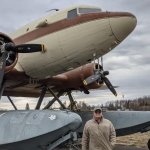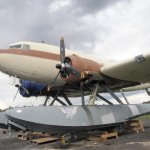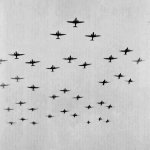And add ampfib floats and it’s a very unique floatplane.
https://www.youtube.com/watch?v=pJ6zTZuq5zw


https://www.youtube.com/watch?v=pJ6zTZuq5zw




We were always told that as long as the DC3 was shaking , farting and making noise it was all good. When it was quite there was a problem.

Sleek, fast, aircraft. The company that the USAF contracted to update the B-26 to the A-26K had previously been converting B-26's into executive aircraft for the civilian market, until the execu-jets took over that market.



We were always told that as long as the DC3 was shaking , farting and making noise it was all good. When it was quite there was a problem.
When all is said and done, make a wind vane of her. This aircraft in Whitehorse apparently spent military time in south East Asia before ending up with Canadian Pacific, they sure get around.
Grizz
Grizz
Built in August of 1942, Douglas serial No. 4665 spent the first three years of her life in the camouflage colours of the United States Army Air Force (USAAF), flying transport missions in India and China.
In April 1946, she was among the C-47s bought by Grant McConachie's newly-formed Canadian Pacific Airlines, to replace the Lockheed Lodestars then on mainline service. Converted to civilian DC-3 configuration with seating for 28 passengers, she was issued the Canadian registration CF-CPY and began a fifteen-year career with CPA. She flew the company's scheduled routes throughout Canada during the mid-1950s, but as CPA upgraded their mainline fleet to Convairs and DC-6Bs, CF-CPY found herself on less glamorous domestic routes such as the run between Whitehorse, the silver-mining town of Mayo and the legendary gold-mining centre, Dawson City.
In April 1960, CF-CPY was sold to Connelly-Dawson Airways of Dawson City. For the next six years she worked as a bush plane, operating on wheels or skis, hauling supplies into remote places such as Old Crow and the oil exploration camps in the Eagle Plains area.
From 1966 until her last flight in November 1970, CF-CPY was again based in Whitehorse, serving the scheduled and charter routes of Great Northern Airways. When GNA declared bankruptcy, she passed into the hands of Northward Airlines, but never flew again. Used for parts for a while, she was finally donated to the Yukon Flying Club in 1977.
Although her total flying time of 31,851 hours is not unusually high for a DC-3, most of that time has been logged either in the Yukon or on connecting routes to the Outside.
Starting in 1977, the Yukon Flying Club restored this northern veteran to its Canadian Pacific Airlines colours for permanent display at the Whitehorse airport. The restoration took four years, but in 1981, she was raised onto the pedestal built by master welder Al Jacobs. Pivoting on its mount, CF-CPY always points into the wind, just as she would have while lined up on the runway for takeoff. Due to the fine balance point, it only takes a 5 knot wind to turn her.
In July 1998, she was brought down from the pedestal for another restoration by the Yukon Transportation Museum (click here for some photos). Following about 1,500 hours of volunteer labour and $20,000 in materials, a pair of cranes lifted her back into position in September 2001.
In July 2009, "Charlie Papa Yankee" once again was brought down from her pedestal, this time to be moved a few hundred meters to a new location at the constantly-expanding Yukon Transportation Museum. There, she remains one of the most popular attractions in Whitehorse.

DC-3s/C-47s were the sched. aircraft when I moved to the NWT in the 70s. Longest flight I took on one was Eskimo Point to Fort Smith return. Absolutely great view of the Barrens.
My son was on a DC-3 charter flight from Yellowknife to Whitehorse. Shortly after take-off, he noticed what appeared to be liquid streaming off the trailing edge. Got the crew's attention, they immediately returned to YK, refilled the tank and installed the cap this time.




I hated working on the ol' Greasy 3. Getting filthy running wiring through the hydraulics bay, or chasing down a dropped socket from the cockpit all the way to the back as it rolled/ bounced to the tail.
Auggie D.
1st Airborne Task Force formation on their way to France.
View attachment 655300
I strongly suspect my fondness for the DC-3 stems from watching the old war movies from the late 40's through the 50's and 60's. Sneaking down to the basement with a bag of Hawkins to watch the old movies broadcast late night in the 70's and early 80's, the Dakotas were the ride of choice for dropping commandos to do commando things against the dirty Nazis. The first movie my dad ever rented for me to watch on our (we were THE ENVY OF THE BLOCK) pop-top Betamax was the Dirty Dozen.
Stirring stuff for an impressionable young lad.
I hated cleaning the DC-3.









































